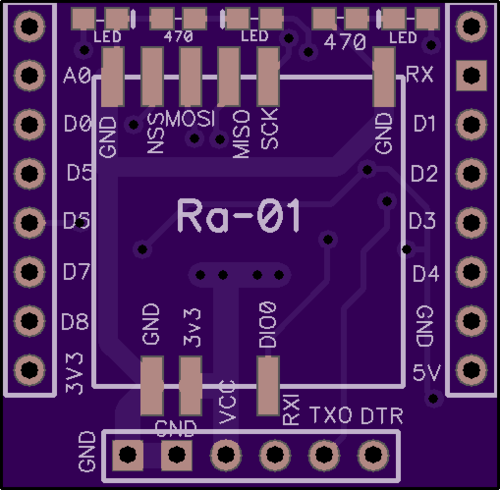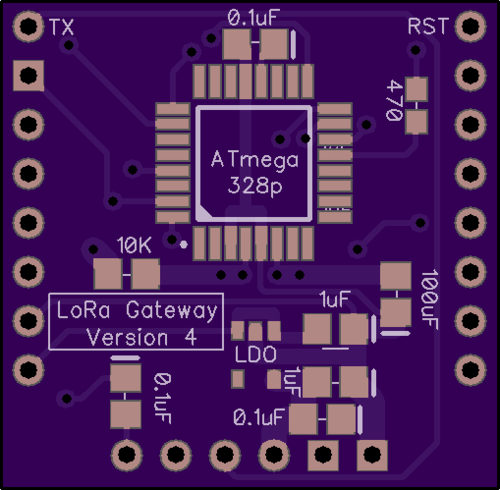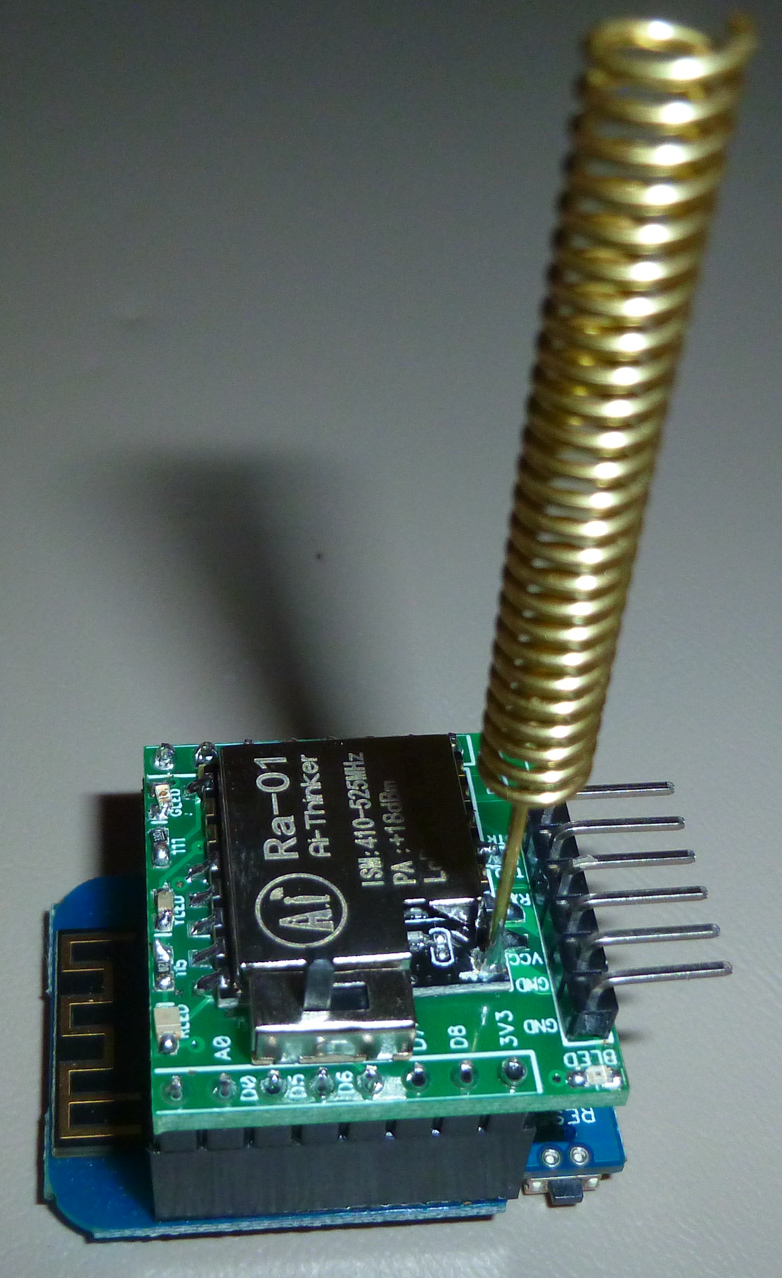LoRa Gateway
-
Made this simple LoRa gateway that combines an Arduino Pro Mini using an Ra-01 LoRa with an ESP8266 D1 Mini running ESP-LINK:

I gave the LoRa radio and Pro Mini their own separate 700ma 3.3v LDO so that the LoRa would not be competing with the D1 for the D1's LDO output.I realize this embodiment falls short of the theoretical ideal, in that it overhangs the ESP8266's antenna. I made it this way because it leverages the LoRa Pro Mini shield I had already developed. My "other" Lora D1 Mini shield I made doesn't have any overhang:
https://www.openhardware.io/view/394/Minimalist-LoRa-Ra-01-Shield-for-WeMos-D1-MiniUltimately, I may combine the two so as to have everything on a single D1 Mini PCB shield, but for now this works well enough. It's also quite easy to assemble.
Because this gateway uses WiFi as the link back to the controller, I can move it around and place it anywhere I like without it being physically tethered to a controller. :)
-
Made this simple LoRa gateway that combines an Arduino Pro Mini using an Ra-01 LoRa with an ESP8266 D1 Mini running ESP-LINK:

I gave the LoRa radio and Pro Mini their own separate 700ma 3.3v LDO so that the LoRa would not be competing with the D1 for the D1's LDO output.I realize this embodiment falls short of the theoretical ideal, in that it overhangs the ESP8266's antenna. I made it this way because it leverages the LoRa Pro Mini shield I had already developed. My "other" Lora D1 Mini shield I made doesn't have any overhang:
https://www.openhardware.io/view/394/Minimalist-LoRa-Ra-01-Shield-for-WeMos-D1-MiniUltimately, I may combine the two so as to have everything on a single D1 Mini PCB shield, but for now this works well enough. It's also quite easy to assemble.
Because this gateway uses WiFi as the link back to the controller, I can move it around and place it anywhere I like without it being physically tethered to a controller. :)
-
@neverdie Did make any tests on range, power, etc?
How do you envisage using it in home automation?
The only Lora GW (LoraWAN for TTN) I have tinkered was Hallard's one:@alexsh1
Hallard's is more like my earlier LoRa shield, except of course with more bells and whistles. This new shield is different, in that it required a separate MCU (the atmega328p in this case) to handle the LoRa radio while the ESP8266 D1 Mini runs ESP-LINK, which is what allows the D1 Mini to perform as an untethered gateway.Hmmm. Come to think of it, if ESP-LINK ran on an ESP32, then I suppose I wouldn't need the atmega328p. Perhaps one core of the ESP32 could run ESP-LINK and the other could manage the LoRa. I should look into that.... Up until just now, I hadn't really seen a reason to use an ESP32 for anything, let alone this.
Anyhow, the purpose of it is, like all gateways, to communicate with nodes and relay information via Domoticz and/or Node Red. For instance, I have leak detectors based on LoRa which need to be managed:
https://www.openhardware.io/view/534/Extremely-Simple-Arduino-Pro-Mini-LoRa-Water-Leak-Detector -
By the way, ESP-LINK comes with a built-in MQTT Client.
-
OK, excellent. I have not tried lora coverage myself (apart from single channel GW for TTN). In fact I did not even built one for my home automation. I think the best usage of it are things like remote location sensors. I know a guy who is utilising lora for HAB (High Altitude Ballooning) projects - http://www.daveakerman.com/
I am trying to think about where at home I can utilise one, but so far RFM69 is covering everything for me. Having said that, your GW is a simple and minimalist one and I can probably build one just to tinker.
PS BTW, water leak sensors - I have a couple of z-wave sensors. They were not DIY, but the advantage is that they just work and look very nice.
-
Hi,
Seems a great project !
Can you clarify the difference with your previous minimalist gateway : the new one is linked to Domoticz controller through wifi, but how was the minimalist linked to controller ? Wasnt'it already through wifi ? Or do you mean this new approach enhances the wifi connectivity by using ESP-Link ? (to be frank, I don't really understand what makes ESP-Link so good, as I never investigated it)br,
Ricorico94 -
Hi,
Seems a great project !
Can you clarify the difference with your previous minimalist gateway : the new one is linked to Domoticz controller through wifi, but how was the minimalist linked to controller ? Wasnt'it already through wifi ? Or do you mean this new approach enhances the wifi connectivity by using ESP-Link ? (to be frank, I don't really understand what makes ESP-Link so good, as I never investigated it)br,
Ricorico94@ricorico94 The main difference is that the newer project can use ESP-LINK on the ESP8266, whereas the first one can't. However, you are correct: with the right programming both can use wi-fi
-
Also, I've confirmed that ESP-LINK doesn't run on the ESP32, so the only way to use it is with an ESP8266 plus an additional MCU, which is what this newer version enables.
-
I think I could understand the wiring thanks to your other projects (the shield for ESP-link on Wemos D1 mini), but I'd appreciate if you could clarify it -just to make sure since I see the 90° connector on picture is not like the one in your shield)
Could you detail also the SW/scripts and settings you use ?
Thanks,
Ricorico94 -
I think I could understand the wiring thanks to your other projects (the shield for ESP-link on Wemos D1 mini), but I'd appreciate if you could clarify it -just to make sure since I see the 90° connector on picture is not like the one in your shield)
Could you detail also the SW/scripts and settings you use ?
Thanks,
Ricorico94@ricorico94
To overcome the overhang, I've since put everything onto a single shield for the ESP8266 D1 Mini:


-
Of course, another way to handle the overhang would be to make it overhang in the opposite direction, where the overhang wouldn't matter:
https://www.openhardware.io/view/273/ESP-LINK-ESP8266-WeMos-D1-Mini-Adapter-Board
That would work too. -
This is even one step further as I understand you get rid of the sandwich Arduino pro mini by soldering directly an ATMEGA328p. It makes the overall setup much more dense indeed. Congratulations !
Could you share the details on software (scripts..) you used for the whole setup ?
I'm also interested in settings you use, because based on another thread, I had seen that some settings for RFM95 had an impact on error rates. -
This is even one step further as I understand you get rid of the sandwich Arduino pro mini by soldering directly an ATMEGA328p. It makes the overall setup much more dense indeed. Congratulations !
Could you share the details on software (scripts..) you used for the whole setup ?
I'm also interested in settings you use, because based on another thread, I had seen that some settings for RFM95 had an impact on error rates.@ricorico94 said in LoRa Gateway:
software (scripts..) you used for the whole setup ?
Nothing meaningful to share as yet. I'm using RadioHead to verify that the hardware works as intended.
-
Currently priced at $3.01 per module with free shipping:
https://www.aliexpress.com/item/LoRa-Series-Ra-01-Spread-Spectrum-Wireless-Module-Ultra-10KM-433M-RF-Chip-SX1278/32799821469.html?spm=a2g0s.13010208.99999999.262.rCAs4B
https://www.aliexpress.com/item/LoRa-Series-Ra-02-Spread-Spectrum-Wireless-Module-Ultra-10KM-433M-RF-Chip-SX1278/32799769669.html?spm=a2g0s.13010208.99999999.265.rCAs4B -
Epilog: the fully integrated ESP-LINK LoRa gateway has no antenna overhang and is working fine. :)

-
-
Hadn't seen it. I'm lately of the mind that it's better to have everything (including sensors) integrated onto a single board.
